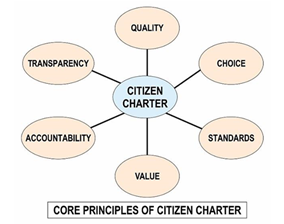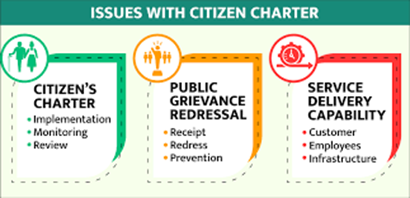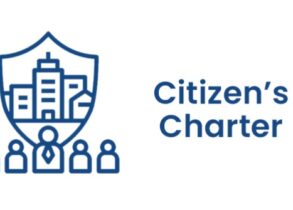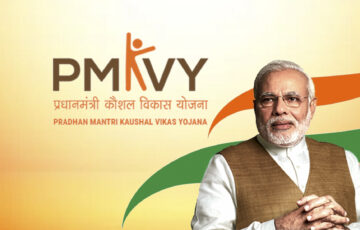Citizen Charter – Part 1
Relevance
- GS Paper 2 – Important aspects of governance, transparency and accountability, e-governance applications, models, successes, limitations, and potential; citizens charters, transparency & accountability, and institutional and other measures.
- Tags: #governance #UPSC #GS2 #citizencharter.
What is the Citizen Charter?
The Citizen’s Charter is a voluntary, written document that outlines the service provider’s dedication to meeting the requirements of citizens or customers. It encompasses information about addressing grievances, what citizens can anticipate from the service provider, and ultimately serves as a tool to uphold trust between service providers and the public.
- The idea of Citizens’ Charter is founded on fostering trust between service providers and their users.
- Originating in the United Kingdom, it was initially introduced and put into action by the Conservative Government under John Major in 1991. The primary objective was to consistently enhance the quality of public services, ensuring they align with the preferences and requirements of the public.
- In 1998, the Labour Government led by Tony Blair reinstated and rebranded the program as “Services First.”
- The introduction of the Citizen’s Charter concept in India took place during a conference of Chief Ministers from different states and union territories in the national capital in May 1997.
- The Department of Administrative Reforms and Public Grievances (DARPG) is responsible for coordinating, formulating, and implementing Citizen’s Charters.
- The Right of Citizens for Time-Bound Delivery of Goods and Services and Redressal of their Grievances Bill, 2011 (Citizens Charter), was introduced in the Lok Sabha in December 2011.
- The bill underwent examination by a Standing Committee, which submitted its report in 2012.
- Unfortunately, the bill lapsed due to the dissolution of the Lok Sabha in 2014.
- It’s essential to note that Citizen’s Charters are not legally binding documents; instead, they function as guidelines aimed at enhancing service delivery to citizens.
Principles of Citizen Charter
The basic objective of the Citizens Charter is to empower the citizen in relation to public service delivery. The Citizen’s Charter set forth six fundamental principles to guide its objectives. The fundamental aim of the Citizens Charter is to grant citizens increased empowerment in the context of receiving public services.
These principles encompassed
- Quality: Enhancing the quality of services, exemplified by the healthcare sector striving to provide better medical facilities and services, ensuring patient safety, and improving overall healthcare outcomes.
- Choice: Offering citizens options whenever feasible, such as various educational boards or curricula, allowing parents to choose the best educational approach for their children.
- Standards: Defining clear expectations and outlining the course of action if these standards are not met, like specifying response times for addressing public grievances.
- Value: Ensuring that public funds are utilized efficiently and effectively, demonstrated through initiatives like the implementation of technology to reduce corruption in subsidy distribution.
- Accountability: Holding both individuals and organizations responsible for their actions, as seen in the implementation of the Right to Information Act, which empowers citizens to demand accountability from government bodies.
- Transparency: Making rules, procedures, schemes, and grievance processes more transparent, as illustrated by online portals that provide information about government schemes and their application processes, thereby reducing opacity and improving accessibility.
Components of Citizen Charter
- Introduction: This section provides an overview of the organization, its mission, and the importance of the Citizen Charter in ensuring transparency and accountability.
- Vision and Mission: The charter typically includes the organization’s vision and mission statements to give citizens a sense of its purpose and objectives.
- Service Standards: This is a critical component that outlines the standards of service quality, including the timeframes for service delivery, the process involved, and the quality benchmarks.
- Citizen’s Rights and Responsibilities: It enumerates the rights and responsibilities of citizens while seeking services. This helps in making citizens aware of their entitlements and obligations.
- Grievance Redressal Mechanism: A well-defined grievance redressal mechanism is essential for addressing complaints or concerns from citizens regarding service quality or any issues related to the charter.
- Feedback Mechanism: This section outlines how citizens can provide feedback, suggestions, or complaints about the services and the charter itself. It could include contact details and online or offline channels for feedback submission.
- Citizen Participation: Some charters encourage citizens to be part of the service improvement process. This may involve mechanisms for involving citizens in decision-making, feedback collection, or service design.
- Review and Monitoring: The charter typically includes provisions for regular review and monitoring to assess the organization’s performance in adhering to the commitments made in the charter.
- Formalize and adopt a charter: To establish and implement a Citizen’s Charter, organizations should formally document and embrace a comprehensive set of commitments and service standards.
The key features of a Citizen Charter encompass clarity, measurability, accessibility, feedback mechanisms, and review, ensuring accountable and transparent public service delivery.
Significance
- Enhanced Service Quality: Citizen Charters improve the quality of public services.
- Empowerment: They make citizens aware of their rights and responsibilities.
- Transparency: Charters provide information about services, reducing corruption.
- Accountability: They hold providers responsible for meeting standards.
- Participation: Encouraging citizen engagement in governance and decision-making.
- Trust-Building: Building trust between the government and the public.
Problems with Citizen charter
- Lack of Awareness: Many citizens are unaware of the existence of Citizen Charters and their entitlements, diminishing their effectiveness.
- Inadequate Implementation: Organizations may not fully execute the commitments in the charters, leading to dissatisfaction among citizens.
- Complexity: Some charters are overly complex or legalistic, making it difficult for the average citizen to understand their rights and responsibilities.
- Weak Enforcement: Enforcement of Citizen Charters can be feeble, with citizens finding it challenging to hold service providers accountable for non-compliance.
- Ineffective Redressal Mechanisms: Grievance redressal procedures may be sluggish or inefficient, leaving citizens frustrated.
- Limited Citizen Participation: Despite the principle of citizen involvement, many charters do not effectively engage citizens in decision-making processes, reducing their impact.
Resolutions for the issues associated with Citizen Charters
The Second Administrative Reforms Commission (ARC) provided recommendations to enhance the effectiveness of Citizen’s Charters, emphasizing the following principles:
- Customization is Key: Recognizing that a uniform approach doesn’t suit all, it is imperative to tailor Citizen’s Charters to the specific requirements and characteristics of each independent unit operating under the organization’s overarching charter.
- Unit-Level Charters: Each distinct unit or department within the organization should formulate its own Citizen’s Charter, aligning with the broader organization’s mission while addressing the unique needs and services it provides.
- Inclusive Consultation: The process of charter development should encompass extensive consultation, which must involve civil society representatives. This ensures that the charter is reflective of public expectations and aspirations.
- Firm Commitments: To instill confidence, the Charter should contain explicit and unambiguous commitments, promising specific service standards and quality benchmarks that the organization is dedicated to delivering.
- Internal Overhaul: To meet the outlined commitments, organizations must consider restructuring their internal processes and structures. This may involve streamlining procedures and reallocating resources as necessary.
- Redress Mechanism: In the event of any failure to meet the charter’s commitments, a robust and accessible grievance redressal mechanism should be in place, offering citizens a channel for addressing their concerns and seeking remedies.
- Regular Evaluation: Periodic assessments and reviews of the Citizen’s Charters are crucial to gauge their effectiveness. These evaluations should be conducted to ensure that the commitments are met and make necessary adjustments.
- End-User Feedback: To measure the success of the charter, feedback from end-users should be actively collected and used as a benchmark for improvement. This feedback is invaluable in making necessary refinements.
- Accountability: Officers and staff responsible for implementing the Citizen’s Charter should be held accountable for the results. This accountability helps ensure that the commitments are met, and if not, appropriate actions are taken.
|
Best practices of Citizen Charter in India
|
Sources: Panchayat Charter, DARPG, TOI.
Mains question
Discuss the significance and challenges of Citizen Charters in the Indian administrative framework. How can they be made more effective in ensuring accountability and citizen-centric public service delivery?










